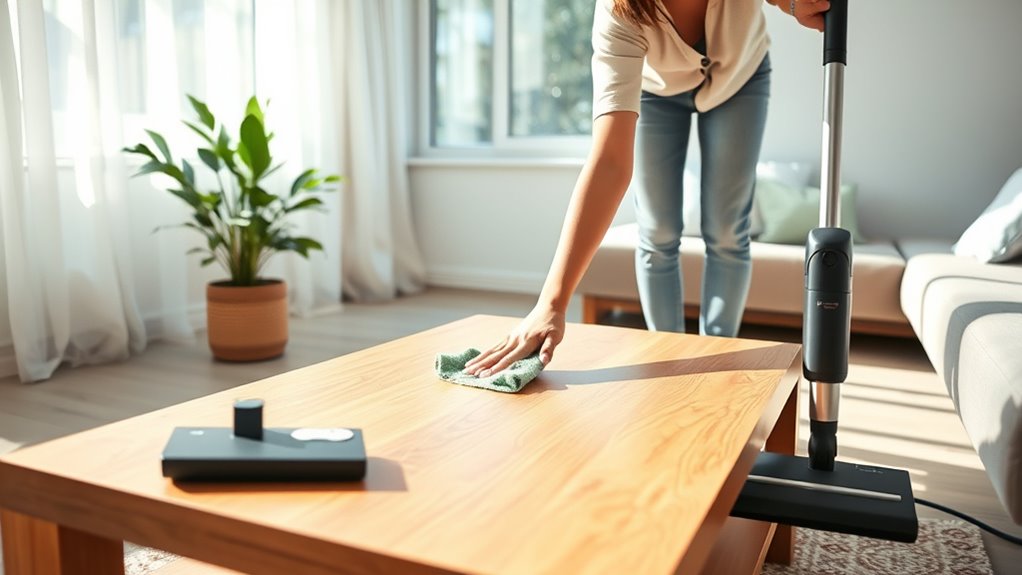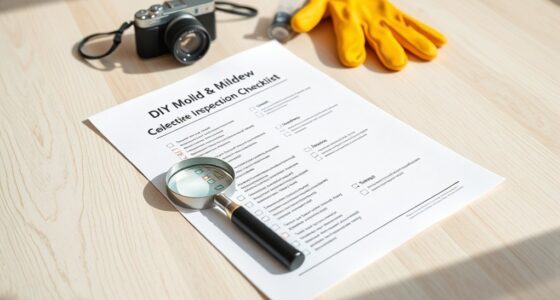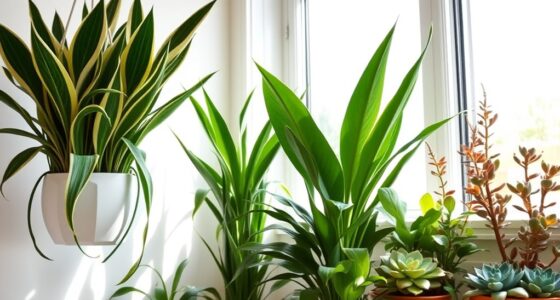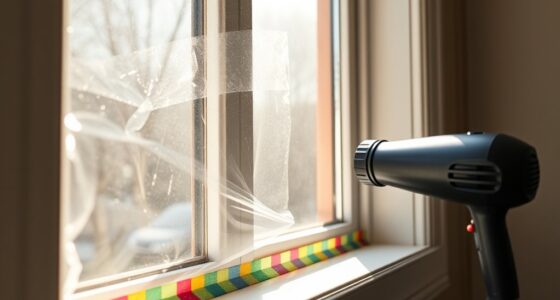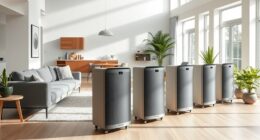To reduce indoor dust on a budget, regularly dust with microfiber cloths, vacuum with HEPA filters, and wash bedding weekly. Keep clutter to a minimum and guarantee proper ventilation by opening windows when possible. Control humidity with affordable dehumidifiers or by using fans to keep dust mites at bay. Maintaining these simple habits can make a big difference, and you’ll discover more effective tips to improve your home’s air quality if you explore further.
Key Takeaways
- Use microfiber cloths for dusting surfaces to trap dust effectively without extra cost.
- Regularly vacuum with HEPA-filter vacuums on carpets and upholstery weekly.
- Maintain indoor humidity between 30-50% with affordable dehumidifiers or ventilation.
- Declutter spaces to reduce dust accumulation and make cleaning easier.
- Clean under furniture and behind appliances regularly to prevent dust buildup.
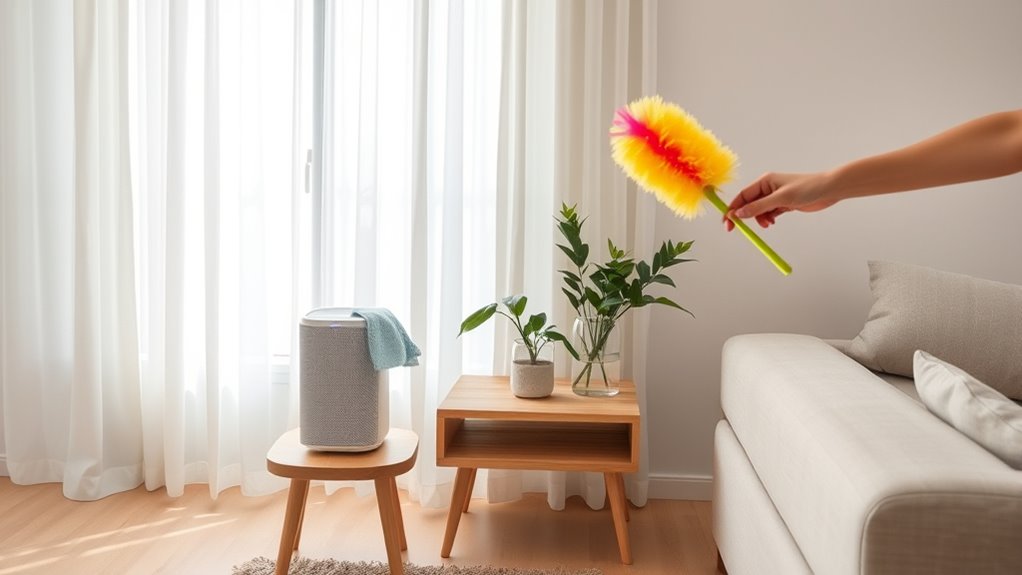
Dust can accumulate quickly indoors, impacting air quality and triggering allergies. If you want to keep your space healthier without spending a fortune, understanding how to reduce dust effectively is essential. One of the most practical steps you can take is improving your air purifier effectiveness. While some air purifiers are more costly, many budget-friendly options still do a good job of filtering out airborne dust particles. Look for models with HEPA filters, which are proven to trap tiny dust mites, pet dander, and other allergens. Regularly replacing or cleaning the filters will maximize their efficiency, ensuring they continue to remove dust from the air. An air purifier working well not only improves your indoor air quality but also contributes markedly to dust mite prevention. Since dust mites thrive in warm, humid environments, keeping the air clean and dry can make a noticeable difference. Additionally, choosing an air purifier with filter maintenance features can simplify ongoing upkeep and help maintain optimal performance.
In addition to using an air purifier, maintaining a routine cleaning schedule helps curb dust buildup. Regular dusting with a microfiber cloth is more effective than a feather duster because it traps dust instead of just spreading it around. Vacuuming carpets and upholstery at least once a week, preferably with a vacuum equipped with a HEPA filter, can drastically cut down dust levels. Don’t forget to clean under furniture and behind appliances, where dust tends to settle. Washing bedding, pillowcases, and curtains weekly also plays a vital role because these items harbor dust mites, which can exacerbate allergies and respiratory issues. Using allergen-proof covers on mattresses and pillows creates a barrier, preventing dust mites from infiltrating your sleep environment.
Reducing clutter is another simple yet effective step. Cluttered spaces trap more dust and make cleaning more difficult. Keep surfaces clear and organized to make dusting and vacuuming more efficient. Additionally, controlling humidity levels between 30-50% can prevent dust mites from thriving. If you live in a particularly humid area, consider using a dehumidifier to maintain ideal moisture levels. Opening windows for ventilation when weather permits helps circulate fresh air and reduces indoor dust accumulation over time. By implementing these budget-friendly strategies—focusing on air purifier effectiveness, dust mite prevention, regular cleaning, and humidity control—you can markedly reduce indoor dust. These steps not only improve air quality but also create a more comfortable, allergy-friendly environment without breaking the bank.
Frequently Asked Questions
How Often Should I Change My HVAC Filters?
You should change your HVAC filters every 1 to 3 months, depending on your filter’s lifespan and your home’s indoor dust levels. Regular HVAC maintenance ensures your system runs efficiently and keeps indoor air cleaner. If you have pets, allergies, or live in a dusty environment, it’s best to replace filters more frequently. Checking the filter monthly helps you determine if it’s time for a change, maintaining ideal airflow and air quality.
Can Houseplants Help Reduce Indoor Dust?
Think of houseplants as tiny dust warriors, quietly fighting dust absorption in your home. Their lush leaves symbolize a natural shield, capturing airborne particles and improving air quality. Plant benefits go beyond aesthetics, helping to reduce indoor dust and allergens. By adding a few easy-care plants, you harness nature’s power to keep your space cleaner and healthier, all without spending much—making your home a fresher, dust-free sanctuary.
Are Air Purifiers Worth the Investment?
Air purifiers are worth considering if you want to improve indoor air quality, especially for allergy sufferers. While they require regular maintenance like filter replacements, their benefits often outweigh the costs. Do a cost comparison to find models that fit your budget, and remember that proper air purifier maintenance keeps it running efficiently. Investing in one can make a noticeable difference in reducing indoor dust and allergens.
What Household Products Increase Indoor Dust?
Certain household products can increase indoor dust, making air purifier maintenance more challenging. Items like dust trapping fabrics, such as heavy curtains or upholstered furniture, tend to attract and hold onto dust particles. Additionally, using products with loose fibers or fibers shed easily can add to indoor dust levels. To minimize this, opt for washable fabrics and regularly clean or vacuum dust trapping surfaces, helping your air purifier work more efficiently.
How Does Pet Dander Affect Dust Levels?
Imagine pet dander as tiny, sneaky ninjas constantly hiding in your home’s corners, ready to trigger allergies at the worst moments. These minuscule allergy triggers cling to dust particles, making your indoor environment more dusty and problematic. When you have pets, you’ll notice dust levels spike, causing sneezing fits and watery eyes. To combat this, regular cleaning and pet grooming help reduce pet dander’s impact on indoor dust.
Conclusion
Think of your home like a sponge soaking up dust—without regular cleaning, it gets overwhelmed. I once ignored dusting for a week, and my allergies skyrocketed. But with simple steps, like vacuuming often and using air purifiers, you can easily keep your space fresh and healthy. Just like squeezing out a sponge, these small efforts can make a big difference, turning your home into a cleaner, more comfortable haven without spending a fortune.
